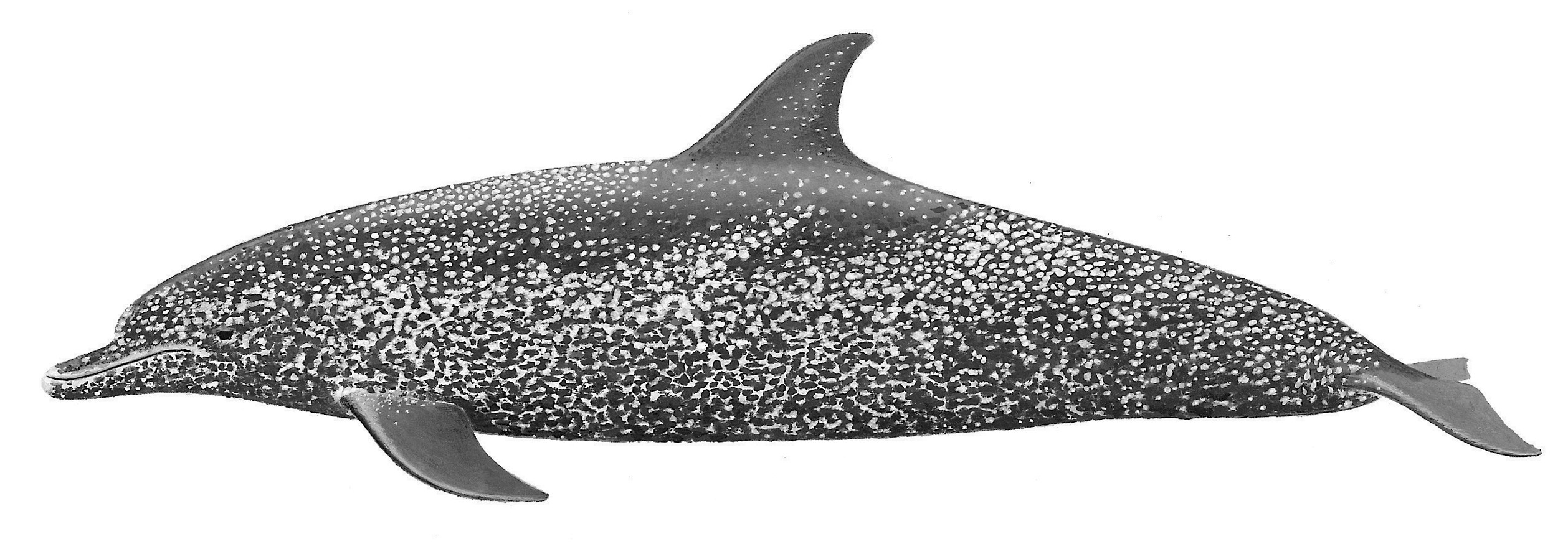ATLANTIC SPOTTED DOLPHIN
Stenella frontalis (Cuvier 1829)
Order Cetacea : Family Delphinidae
DESCRIPTION. A rather small, long-snouted, spotted dolphin; purplish gray, appearing blackish at a distance, usually with numerous, small, white or gray spots on sides and back; sides paler, belly whitish; young grayish, unspotted. Dorsal fin high and strongly recurved, strongly concave at rear; beak deeper than wide and about 6% of total length of animal. Teeth small and slightly incurved, especially toward tip of snout in upper jaw; upper jaw teeth vary from 31/31 to 37/34; height of teeth above jawbones seldom over 10 mm. Total length, 2.2 m; girth in front of dorsal fin, 1.2 m; length of anterior edge of dorsal fin, 431 mm; width of flukes, 661 mm. Weight, 125 kg.

DISTRIBUTION. The spotted Atlantic dolphin is endemic to the warm and temperate regions of the Atlantic Ocean. Almost all of the records of this species in the Gulf of Mexico are from the offshore waters over the continental shelf, where it is second in abundance only to the common bottlenose dolphin, Tursiops truncatus.
SUBSPECIES. The taxonomic status of S. frontalis is unresolved, and further research is required to determine if subspecies assignments are justified.
HABITS. Atlantic spotted dolphins may be seen in groups of up to 50 animals, but smaller groups of 6–10 are more common. They eat small fishes, including herring, anchovies, and flounder, as well as squid.
These dolphins make a variety of sounds used in echolocation and communication. Sounds are described as loud whistles, chirps, low-intensity click trains, squawks, barks, growls, and cracks.
These dolphins mate and calve in summer. Sexual behavior has been observed in the Gulf of Mexico in mid-May. The gestation period lasts 12 months, and calves are born in offshore waters.
Although this dolphin is a common offshore resident of the Gulf of Mexico, it may move into nearshore waters in late spring and summer in Florida. That movement may be related to the movements of certain prey species for the dolphins; such migrations are not known for Texas waters.
POPULATION STATUS. Common; strandings and observations. The Atlantic spotted dolphin is a common offshore dolphin of the Gulf of Mexico that only rarely strands along the Texas coast. The species, which was commonly sighted during the GulfCet surveys, has been observed from about the 20 to the 200 m (66–656 ft.) depth curves. There are a few scattered records out to 1,000 m (3,281 ft.), but the greatest concentrations are around the 100 m isobath. The population in the western portion of the Gulf has been estimated as about 500 to 2,000 animals.
CONSERVATION STATUS. Because of its rarity in the stranding record, the Atlantic spotted dolphin is listed as threatened by TPWD, but it does not appear on the USFWS list of endangered or threatened species and is listed by IUCN as "data deficient." The GulfCet surveys, together with other survey sightings, strongly argue against the listing of this species by TPWD.
REMARKS. Gulf populations of this species were previously known as S. plagiodon, the scientific name commonly used in the historical literature.
From The Mammals of Texas, Seventh Edition by David J. Schmidly and Robert D. Bradley, copyright © 1994, 2004, 2016. Courtesy of the University of Texas Press.
Natural Science Research Laboratory
-
Address
Museum of Texas Tech University, 3301 4th street, Lubbock, TX 79409 -
Phone
806.742.2486 -
Email
nsrl.museum@ttu.edu

